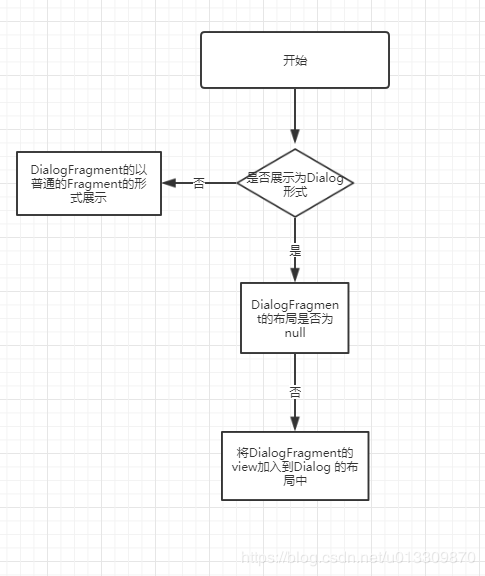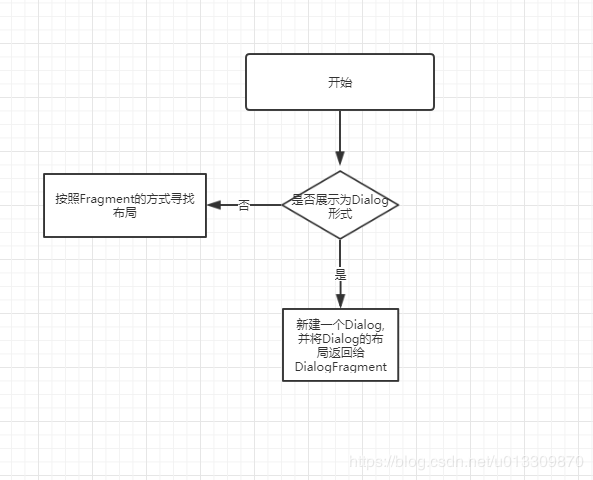前言
最近项目中用到了DialogFragment,用起来很方便,但是坑比较多,于是自己研究了下源码,理清楚DialogFragment中Dialog和Fragment的关系,以及DialogFragment的原理。
DialogFragment的使用方法
1、重写onCreateDialog方法创建AlertDialog
1.1 简单的AlertDialog
public class FireMissilesDialogFragment extends DialogFragment {
@Override
public Dialog onCreateDialog(Bundle savedInstanceState) {
// Use the Builder class for convenient dialog construction
AlertDialog.Builder builder = new AlertDialog.Builder(getActivity());
builder.setMessage(R.string.dialog_fire_missiles)
.setPositiveButton(R.string.fire, new DialogInterface.OnClickListener() {
public void onClick(DialogInterface dialog, int id) {
// FIRE ZE MISSILES!
}
})
.setNegativeButton(R.string.cancel, new DialogInterface.OnClickListener() {
public void onClick(DialogInterface dialog, int id) {
// User cancelled the dialog
}
});
// Create the AlertDialog object and return it
return builder.create();
}
}
1.2 自定义布局的AlertDialog
如果想让对话框具有自定义布局,请创建一个布局,然后通过调用 AlertDialog.Builder 对象上的 setView() 将其添加到 AlertDialog。
@Override
public Dialog onCreateDialog(Bundle savedInstanceState) {
AlertDialog.Builder builder = new AlertDialog.Builder(getActivity());
// Get the layout inflater
LayoutInflater inflater = getActivity().getLayoutInflater();
// Inflate and set the layout for the dialog
// Pass null as the parent view because its going in the dialog layout
builder.setView(inflater.inflate(R.layout.dialog_signin, null))//R.layout.dialog_sign 自定义布局
// Add action buttons
.setPositiveButton(R.string.signin, new DialogInterface.OnClickListener() {
@Override
public void onClick(DialogInterface dialog, int id) {
// sign in the user ...
}
})
.setNegativeButton(R.string.cancel, new DialogInterface.OnClickListener() {
public void onClick(DialogInterface dialog, int id) {
LoginDialogFragment.this.getDialog().cancel();
}
});
return builder.create();
}
1.3 DialogFragment与所在的Acitivty交互
当用户触摸对话框的某个操作按钮或从列表中选择某一项时,DialogFragment 可能会执行必要的操作,如果想将事件传递给打开该对话框的 Activity 或Fragment。 可以为每种点击事件定义一种方法。
public class NoticeDialogFragment extends DialogFragment {
@Override
public Dialog onCreateDialog(Bundle savedInstanceState) {
// Build the dialog and set up the button click handlers
AlertDialog.Builder builder = new AlertDialog.Builder(getActivity());
builder.setMessage(R.string.dialog_fire_missiles)
.setPositiveButton(R.string.fire, new DialogInterface.OnClickListener() {
public void onClick(DialogInterface dialog, int id) {
//将点击Positive事件传递给所在的Activity
mListener.onDialogPositiveClick(NoticeDialogFragment.this);
}
})
.setNegativeButton(R.string.cancel, new DialogInterface.OnClickListener() {
public void onClick(DialogInterface dialog, int id) {
//将点击Negative 事件传递给所在的Activity
mListener.onDialogNegativeClick(NoticeDialogFragment.this);
}
});
return builder.create();
}
//定义一个监听的接口,DialogFragment所在的Activity实现这个接口
public interface NoticeDialogListener {
public void onDialogPositiveClick(DialogFragment dialog);
public void onDialogNegativeClick(DialogFragment dialog);
}
// Use this instance of the interface to deliver action events
NoticeDialogListener mListener;
// Override the Fragment.onAttach() method to instantiate the NoticeDialogListener
@Override
public void onAttach(Activity activity) {
super.onAttach(activity);
try {
mListener = (NoticeDialogListener) activity;
//获取DialogFragment所在的Activity,执行mListener方法时会自动调用Actvity中相应的方法
} catch (ClassCastException e) {
throw new ClassCastException(activity.toString()
+ " must implement NoticeDialogListener");
}
}
...
}
DialgFragment所在的Acitivity如下
public class MainActivity extends FragmentActivity
implements NoticeDialogFragment.NoticeDialogListener{
...
public void showNoticeDialog() {
// 创建DialogFragment的实例来显示
DialogFragment dialog = new NoticeDialogFragment();
dialog.show(getSupportFragmentManager(), "NoticeDialogFragment");
}
//当DialogFragment中发生相应的点击事件时会自动调用到这里面的两个方法。
@Override
public void onDialogPositiveClick(DialogFragment dialog) {
// 用户点击DialogFragment中的positive按钮
...
}
@Override
public void onDialogNegativeClick(DialogFragment dialog) {
// 用户点击DialogFragment中的 negative 按钮
...
}
2.重写onCreateView
有时候需要弹出框,但是不需要AlertDialog里面的功能,就可以重写onCreateView实现自己的布局
@Nullable
@Override
public View onCreateView(@NonNull LayoutInflater inflater, @Nullable ViewGroup container, @Nullable Bundle savedInstanceState) {
View view = inflater.inflate(R.layout.message_share_websit_dialog, container);
initView(view);
return view;
}
3 以弹出框方式显示对话框和全屏Fragment方式显示对话框
有时候在大尺寸的手机或者pad上可以将DialogFragment作为弹出框形式展示,在小屏幕的手机上作为一个普通Fragment的形式展示。
public class CustomDialogFragment extends DialogFragment {
@Override
public View onCreateView(LayoutInflater inflater, ViewGroup container,
Bundle savedInstanceState) {
// Inflate the layout to use as dialog or embedded fragment
return inflater.inflate(R.layout.purchase_items, container, false);
}
/** The system calls this only when creating the layout in a dialog. */
@Override
public Dialog onCreateDialog(Bundle savedInstanceState) {
// The only reason you might override this method when using onCreateView() is
// to modify any dialog characteristics. For example, the dialog includes a
// title by default, but your custom layout might not need it. So here you can
// remove the dialog title, but you must call the superclass to get the Dialog.
Dialog dialog = super.onCreateDialog(savedInstanceState);
dialog.requestWindowFeature(Window.FEATURE_NO_TITLE);
return dialog;
}
}
以下代码可根据屏幕尺寸决定将片段显示为对话框还是全屏 UI:
public void showDialog() {
FragmentManager fragmentManager = getSupportFragmentManager();
CustomDialogFragment newFragment = new CustomDialogFragment();
if (mIsLargeLayout) {
// 如果时大屏幕的设备,显示为弹出框方式
newFragment.show(fragmentManager, "dialog");
} else {
// 如果是小屏幕的手机,显示为全屏的Fragment
FragmentTransaction transaction = fragmentManager.beginTransaction();
// 设置动画效果
transaction.setTransition(FragmentTransaction.TRANSIT_FRAGMENT_OPEN);
//获取android.R.id.content布局,并将newFragment加入到布局中
transaction.add(android.R.id.content, newFragment)
.addToBackStack(null).commit();
}
}
DialogFragment中源码分析
DialogFragment的继承结构
public class DialogFragment extends Fragment
implements DialogInterface.OnCancelListener, DialogInterface.OnDismissListener
可以看出DialogFragment继承了Fragment是在Fragment基础之上封装的,因此DialogFragment既可以作为Dialog来使用也可以作为单独的Fragment来使用。
问题1:DialogFragment既然继承了Fragment为什么会显示成一个Dialog的形式?
在DialogFragment内部定义了一个Dialog mDialog;当我们重写了onCreateDialog()方法时,mDialog就是在onCreateDialog()中返回的Dialog,否则就会默认返回一个Dialog。如果我们重写了onCreateView方法就将该布局加入到Dialog中。这个方法可以在onActivityCreated中找到
@Override
public void onActivityCreated(Bundle savedInstanceState) {
super.onActivityCreated(savedInstanceState);
if (!mShowsDialog) {
return;//如果不显示为Dialog形式的话不做任何处理直接返回。
}
View view = getView();
//获取dialogFragment的布局,这个布局就是我们在onCreateView中找到的布局。
if (view != null) {
if (view.getParent() != null) {
throw new IllegalStateException(
"DialogFragment can not be attached to a container view");
}
mDialog.setContentView(view);//如果布局不为null的话,将我们定义的布局加入到mDialog中。
}
final Activity activity = getActivity();
if (activity != null) {
mDialog.setOwnerActivity(activity);
}
mDialog.setCancelable(mCancelable);
mDialog.setOnCancelListener(this);
mDialog.setOnDismissListener(this);
if (savedInstanceState != null) {
Bundle dialogState = savedInstanceState.getBundle(SAVED_DIALOG_STATE_TAG);
if (dialogState != null) {
mDialog.onRestoreInstanceState(dialogState);
}
}
}
对应的流程图:

onGetLayoutInflater重写了Fragment中获取显示布局的过程,这个过程也决定了最后DialogFragment最后显示的效果。
@Override
public LayoutInflater onGetLayoutInflater(Bundle savedInstanceState) {
if (!mShowsDialog) {
//如果不显示Dialog的话直接调用Fragment中的onGetLayoutInflater方法
return super.onGetLayoutInflater(savedInstanceState);
}
mDialog = onCreateDialog(savedInstanceState);//否则新建dialog
if (mDialog != null) {
setupDialog(mDialog, mStyle);//设置Dialog的样式
return (LayoutInflater) mDialog.getContext().getSystemService(
Context.LAYOUT_INFLATER_SERVICE);//返回dialog的布局
}
return (LayoutInflater) mHost.getContext().getSystemService(
Context.LAYOUT_INFLATER_SERVICE);
}
创建Dialog,如果重写了该方法就返回我们定义的Dialog,否则返回默认的Dialog.
@NonNull
public Dialog onCreateDialog(Bundle savedInstanceState) {
return new Dialog(getActivity(), getTheme());
}
流程图如下:

问题2 DialogFragment展示
DialogFragment的展示也有不同的方式,实际两种方式本质上是一样的,都是需要得到FragmentTransaction来对DialogFragment的进行管理。
public void show(FragmentManager manager, String tag) {
mDismissed = false;
mShownByMe = true;
FragmentTransaction ft = manager.beginTransaction();
//获取FragmentTransaction并将
//当前DialogFragment的实例加入到FragmentTransaction中
ft.add(this, tag);
ft.commit();//提交
}
public int show(FragmentTransaction transaction, String tag) {
mDismissed = false;
mShownByMe = true;
transaction.add(this, tag);
mViewDestroyed = false;
mBackStackId = transaction.commit();
return mBackStackId;
}
问题3 DialogFragment消失
DialogFragment的消失函数有onDismiss和dismiss两个,都调用了dismissInternal(boolean allowStateLoss) 方法,但是传入的参数不同;allowStateLoss代表是否允许不保存DialogFragment的状态。
传入自定的Dialog,调用 dismissInternal(true);不保存DialogFragment的状态。
public void onDismiss(DialogInterface dialog) {
if (!mViewDestroyed) {
dismissInternal(true);
}
}
dismissInternal(false);保存DialogFragment的状态
@Override
public void dismiss() {
dismissInternal(false);
}
具体的消失逻辑在dismissInternal(boolean allowStateLoss)实现下面具体分析源码
void dismissInternal(boolean allowStateLoss) {
if (mDismissed) {
return;//如果当前的DialogFragment的已经消失了,就直接返回
}
mDismissed = true;
mShownByMe = false;
if (mDialog != null) {
mDialog.dismiss();//如果mDialog不为null那么想将mDialog消失
}
mViewDestroyed = true;
if (mBackStackId >= 0) {//如果mBackStackId >0则将BackStack中所有的mBackStackId之前的DialogFragment都弹出栈
getFragmentManager().popBackStack(mBackStackId,
FragmentManager.POP_BACK_STACK_INCLUSIVE);
mBackStackId = -1;
} else {
FragmentTransaction ft = getFragmentManager().beginTransaction();
ft.remove(this);//从FragmentTransaction中移除当前的DialogFragment
if (allowStateLoss) {
ft.commitAllowingStateLoss();//如果允许不保存状态执行
} else {
ft.commit();//提交
}
}
}
由上可知,DialogFragment的消失其实有两步,首先看自带的mDialog是不是null如果不是null则先将mDialog消失,然后再移除DialogFragment。 连接:blog.csdn.net/u013309870/…